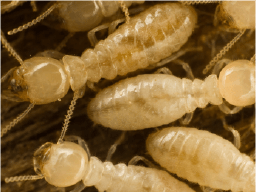Identifying Different Types of Bees
Need to get rid of bees? Read on to learn the answers to all of your important questions. Need help? Call our professionals today to get started.
Schedule Today!What Do Bees Look Like?
Bees share many common characteristics with other flying insects. Bees are often confused with yellow jackets and wasps due to their coloring. They are also often confused with flies for the same reason. Striped yellow and black flies evolved to look similar to bees and wasps as a means of protection against predators. Flies can also be pollinators just like bees. So how can you tell which is what?
Bees are characterized by their distinct pair of large, compound eyes which cover most of the head. They have antennae which have 12-13 segments (depending on the sex of the bee) and have a distinctive elbow joint part way down. The thorax of the bee has three segments, each with a pair of legs. The hind two segments have a pair of membranous wings. Lastly, bees have an abdomen that has nine segments, the last three of which are part of the stinger.
Different Types of Bees
Bees are flying insects known for their role in pollination and producing honey. There are over 16,000 bee species in existence around the world, and around 4,000 of these species live in North America. Depending on where you live and what kinds of plants grow in your area, you will be more familiar with some bee species than others. Bees come in a diverse range of size, color, shape and living habits, making identification difficult.
We often associate bees with living in a hive, however, most bees build solitary nesting compartments in the ground or in a hollow area of a tree or rock cavity. You may often see several solitary female bee nest chambers close to one another, forming something of an informal social colony. This is quite different from other bees, particularly the bumble bee, carpenter bee and honey bee hives that are home to thousands of members of a colony that work together as one larger organism.
How To Identify Different Types Of Bees
The bees that you will most commonly come across in your yard are the bumble bee, the honey bee, the carpenter bee and the sweat bee.
Honey bees may be different in color depending on where you live, but most often, honey bees have black stripes alternating with bands of brown to light-brown hairs.
Carpenter bees are around the same size as honey bees and tend to be totally black. Carpenter bees are often confused with bumble bees, however, carpenter bees have a shiny abdomen, while bumble bees are covered in fur.
Sweat bees come in all kinds of colors including a brilliant metallic green. They are very small, at 1/4 of an inch long. They are attracted to human sweat and you may find them buzzing around you while you walk through your garden.
Bumble bees are docile and large and are characterized by their large, fuzzy bodies. They are about 1/2 an inch in length and can come in a variety of patterns of black, white, yellow, orange and reddish-brown.
Find A Pest Specialist For Bee Control
If you are concerned about bees in your home, please give us a call or fill out the form on this page. PestControlExperts.com is a team of experts who are highly qualified to provide the best recommendations for you and your home, no matter which part of the United States you live in.
Call 855-891-5410














